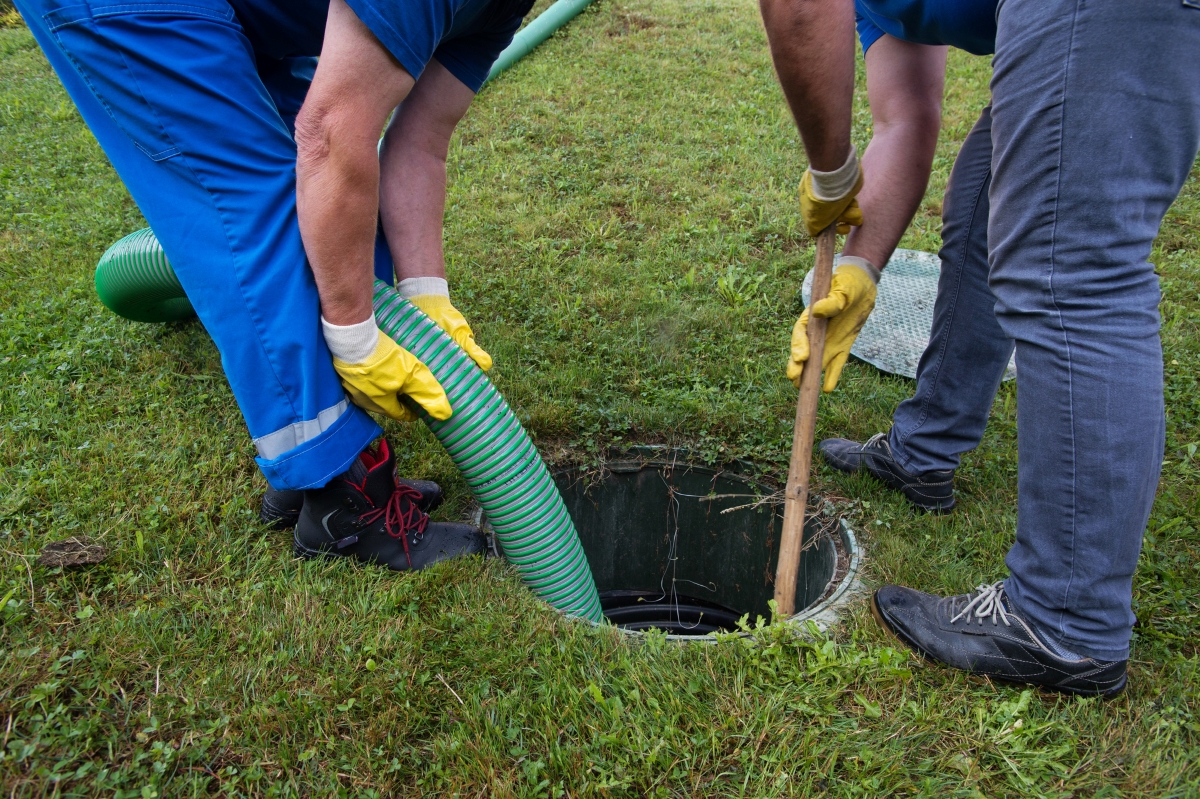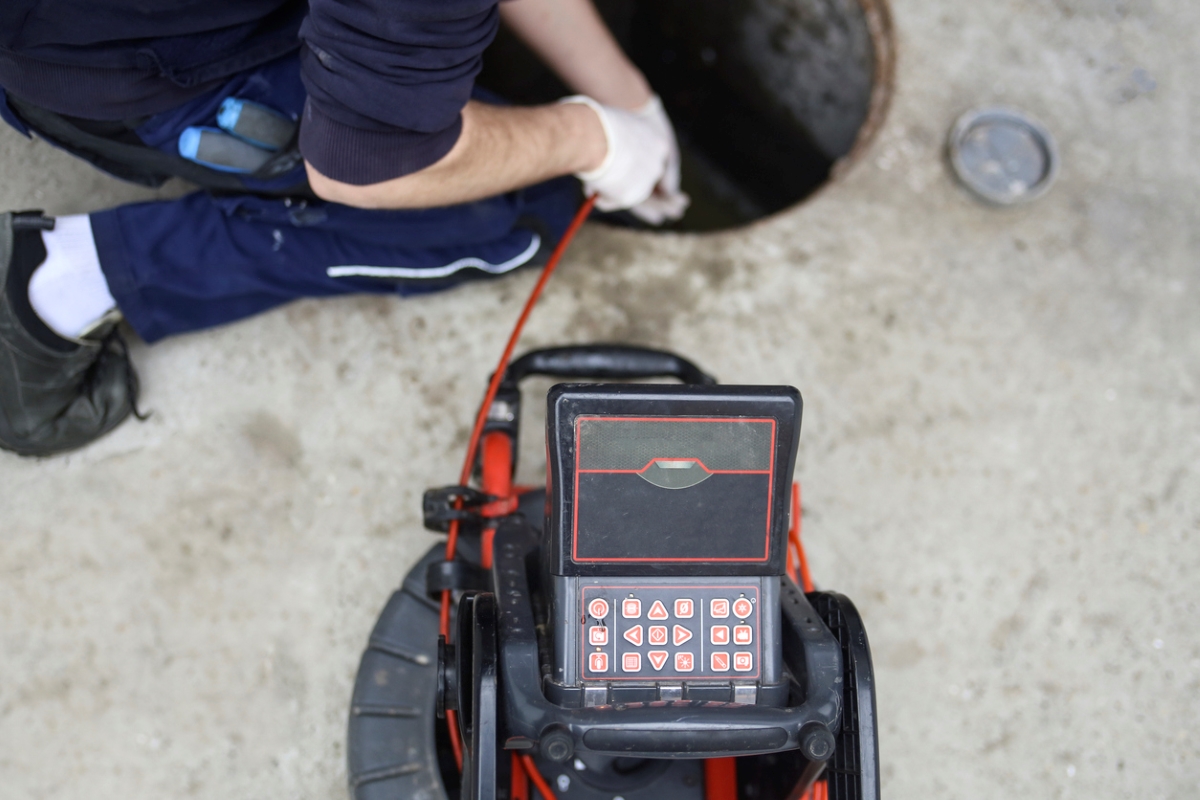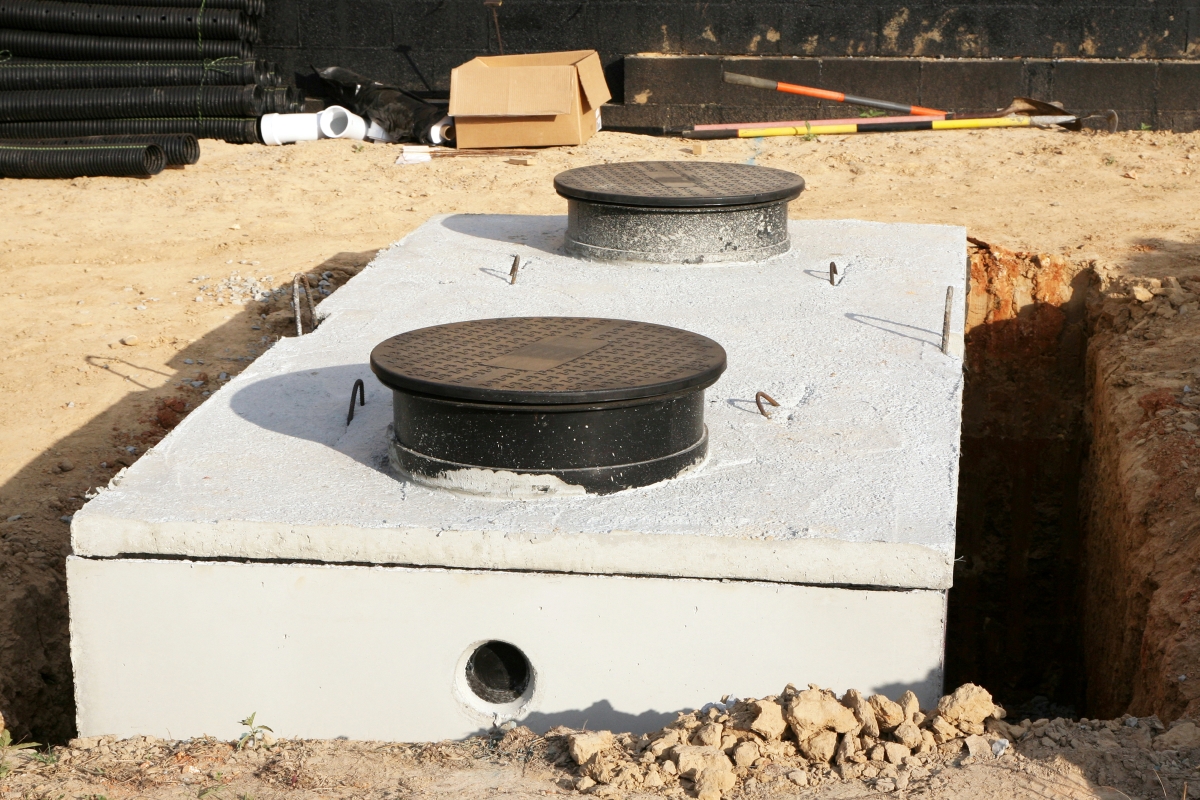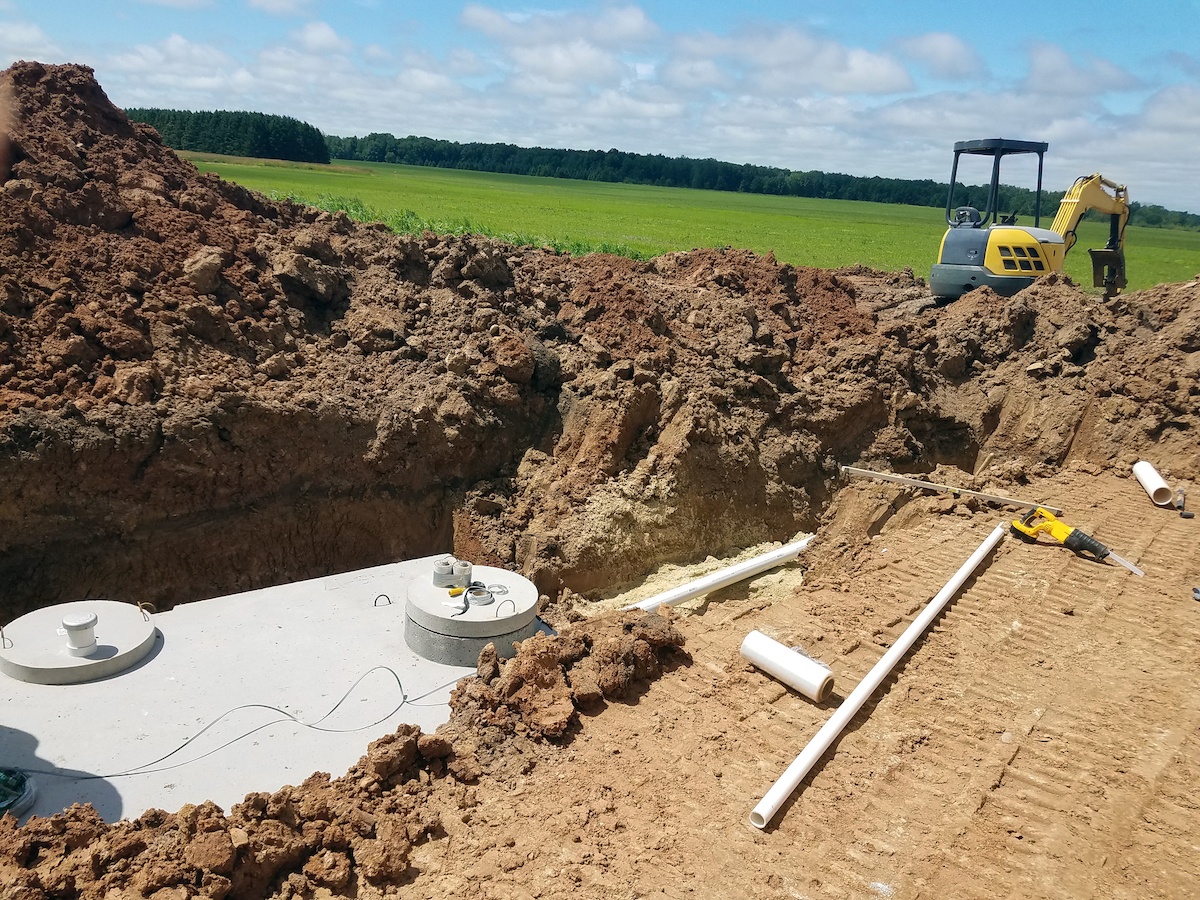We may earn revenue from the products available on this page and participate in affiliate programs. Learn More ›
When used in a home’s sale listing, the phrase “septic system” has a tendency to scare away potential buyers. Some home buyers may see the system as antiquated, expensive to repair, or hard to maintain. But septic systems aren’t as intimidating as they sound.
With a solid maintenance record and a good inspection, a septic tank and the associated parts can easily last for decades. If you’re thinking about scheduling an showing to see a home that has this type of system buried out back, don’t cross it off your list before learning the facts about septic systems.
Below, find out how septic systems work, the misconceptions about septic systems, how to maintain them, how to find a septic system inspector, and the signs that a system may be failing.
1. How do septic systems work?

A septic system is designed to filter wastewater. It consists of a large septic tank, distribution box, baffles, and a drain field, all of which are underground. The drain field is also called a septic field or leach field, and it’s the network of perforated pipes that spread out from the septic tank and release the filtered wastewater into the soil.
The wastewater from your home—from toilets, sinks, showers, and appliances—exits the house through the pipes into the tank. Once in the tank, the solid matter (also known as sludge) settles to the bottom. The buildup over time provides a luxurious home for beneficial anaerobic bacteria, which work to break down the solids and release the grease, oil, and fats (the scum).
The byproducts rise to the top, where they hang out in the tank, kept separate by a set of baffles. Meanwhile, the remaining wastewater (also called effluent) flows through outlet pipes into the disposal bed or drain field, where it is slowly and safely filtered by the soil.
2. Are septic systems as unreliable and difficult to maintain as I’ve heard?
There are many misunderstandings about septic systems that may give you pause if you’re considering buying a home that has one. Let’s set the record straight on some of the most common misperceptions.
- “Nobody really has a septic system anymore.” Actually, the Environmental Protection Agency (EPA) says about 20 percent of homes in the U.S. have a septic system—that’s one in five residences.
- “Septic systems routinely fail.” With solid maintenance, a septic system can last for up to 40 years or even longer, according to the EPA.
- “Septic systems stink.” A properly maintained septic system would not emit any unpleasant odors. If you smell a bad odor emitting from drains or the septic area itself, there’s a problem.
- “A septic system can contaminate a well.” If a system is installed properly and maintained regularly, it will not contaminate a well on the property. According to the Centers for Disease Control and Prevention (CDC), the system must be located at least 50 feet from a well to help ensure the separation of drinking water and wastewater.
- “A home inspection will look at the septic system.” A home inspection tends to focus on systems within the home, and rarely includes more than a cursory look at the septic. To get a complete picture, look for a professional who knows exactly how a septic system works and how to thoroughly inspect it.
3. How do you maintain a septic system?
Septic systems require attention and maintenance to run smoothly. The good news is that maintaining a septic system is rather simple. Here’s how to keep it working properly.
- Be careful of what you send through the system. Paint, chemicals, kitty litter, coffee grounds, disposable wipes, diapers, and feminine products should never be sent down the drain. Any of these could clog the septic system.
- Avoid using any additives in the system. According to the National Small Flows Clearinghouse, there are two types of additives: chemical and biological. Though these products are marketed to do everything from accelerate the breakdown of solids to improve the state of the drain field, they usually wreak havoc on the bacteria that are supposed to keep the system working well.
- Never park or drive over the drain field, as the weight of a vehicle could damage the pipes.
- Be careful when planting bushes or trees near the drain field. Some water-loving species, such as weeping willows, can send roots into the drain field, outlet pipes, or even the septic tank itself. The Virginia Cooperative Extension suggests a good rule of thumb: If a tree will grow to be 25 feet tall, keep it at least 25 feet away from the drain field.
- Get the tank pumped out every 2 or 3 years, on average, by a professional septic service. Typically, the professional will also conduct a visual inspection of the components at the same time.
- At the first sign of potential failure, call a professional! The sooner you call, the cheaper a fix might be.
4. How often should a septic tank be pumped?

An important part of owning a septic tank is knowing how often to pump a septic tank so it continues to run well. The EPA recommends that a septic tank should be pumped every 2 to 3 years. Households with high usage or a higher number of occupants, and systems with additional mechanical or electrical components, require more frequent inspection.
Septic pumping costs between $375 and $900 for a 1,250-gallon tank, which is a common size. For those living in urban areas or those who have difficulty accessing tanks, the cost is usually a lot greater.
5. Should I have the septic system inspected before making an offer on a home?
When placing an offer on a home, that offer is almost always contingent on the results of a full inspection of the property, including the septic system. It’s important to remember that what is said on a seller’s disclosure form is not a good substitute for an inspection. The homeowner typically won’t have the skills or equipment to properly inspect the system. If there are hidden problems, the homeowner might not be aware of them.
It’s also vital to note that a home inspection usually doesn’t include a good look at the septic system. A general home inspection will evaluate the home itself, the systems within the home (such as plumbing and electrical), the condition of the roof, and possibly some of the exterior areas.
A thorough look at the septic system often requires training that a general home inspector might not have. Therefore, always go to a septic system professional to get the inspection.
6. How do I hire a septic tank inspector, and what do they do?

As with hiring most professionals for home maintenance, it’s best to seek out a septic inspector with an excellent reputation. Your neighbors and your real estate agent may be able to offer a few good leads. Keep in mind that choosing someone local will also ensure that they’re familiar with applicable regulations—neighboring municipalities may have different rules regarding septic tanks.
Call each potential inspector and ask questions about how they handle the job; for instance, some might use cameras to look at the distribution box and drain field, while others might dig to do their inspection. This can make a difference in cost, but it might also make a difference in aesthetics, especially if you don’t want delicate landscaping disturbed.
Once the inspection begins, the professional will search out pumping and maintenance records, look for signs of leakage or backup, measure the sludge and scum levels, establish the age of the tank, and more. The inspector will also assess the condition of the drain field, tank, and all associated parts and confirm that the tank is properly sized for the home.
If the home has additions that were created after the septic tank was initially installed, an inspector may make recommendations to accommodate. For instance, a 2-bedroom home needs a different-size tank than a 3-bedroom home.
7. What are the signs that a septic system needs to be replaced?
It’s important to recognize the signs of a coming failure before it happens. Failure of a septic system might go unnoticed at first. It’s helpful to watch for the signs so you can schedule a replacement before it fails, which include:
- Gurgling sounds from exterior drains;
- Slow-moving interior drains in bathtubs and sinks;
- Bad odors from the septic tank, drain field, or drains in the home;
- Wet areas appearing above the drain field;
- Sewage backing up into the house;
- Toilets taking longer to flush; and
- Vegetation over the drain field suddenly becoming lush and full, indicating a possible blockage or break in the outlet pipes.
8. How much does a new septic system cost?

The typical cost of a new septic system is between $500 and $16,000. While a septic system is a cost-effective solution in rural areas and more remote suburbs, the cost depends on the size of the home, the amount of waste, and the type and construction of the septic tank.
A 2-bedroom home would typically need a 750-gallon tank, which ranges in cost between $700 and $1,200. A 3,000-gallon tank is able to handle the needs of 15 occupants and can cost between $2,900 and $3,900. Material also affects cost. Plastic is the least expensive, starting at $500, concrete tanks start at around $700, and fiberglass tanks are $1,200 or more.
Replacing or updating parts for a septic system can cost as little as $30 to replace a tank lid and up to as much as $7,000 to replace the drain field. Other repairs include baffle replacement ($300 or more), filter replacement ($230 or more), and septic tank pump replacement ($800 or more).
FAQs
The three types of septic systems are conventional systems, chamber systems, and drip distribution systems. Conventional systems are typically used for houses. Because it is made of a series of closed chambers, a chamber system is usually chosen for high water table areas. Drip systems tend to be easier to install, but they require more maintenance.
A septic system can last 40 years if it is well maintained, according to the EPA. Make sure to have the septic system inspected before you buy a new home. This will give you an idea of how many years that septic system is expected to last.
The alternatives to a septic tank include an aerobic treatment system, composting waste, and a drip system.
• An aerobic treatment system usually requires a second tank, so the cost is greater than a regular septic system. However, the aerobic process breaks down waste more effectively so a smaller drain field is needed. This makes it a good choice for smaller properties.
• A composting waste system is often used for off-the-grid toilets that are not hooked up to a septic system. They require more day-to-day attention than other systems.
• Drip septic systems use drip tubing and release in timed doses. The cost is more than that of a regular septic system, but it is better for shallow soil environments.
Chemicals like oil-based paint, paint thinners, lubricants, gasoline, weed killers, foaming cleaners, and chlorine-based cleaners are bad for a septic tank. They can contaminate the surrounding environment and kill the bacteria that’s needed inside the septic tank. This can make it difficult or impossible for matter to break down.
Final Thoughts
Used in about 20 percent of homes in the United States, septic systems remove wastewater from a home. While septic systems may require a little more work than using a public sewer system, they aren’t as difficult to keep running efficiently as their reputation may suggest.
Homeowners who regularly inspect their septic systems and keep their eyes peeled for signs of possible issues can expect their septic system to last for as long as 40 years. For home buyers considering a property with a septic system, it’s important to have the system looked over by a professional septic inspector.


